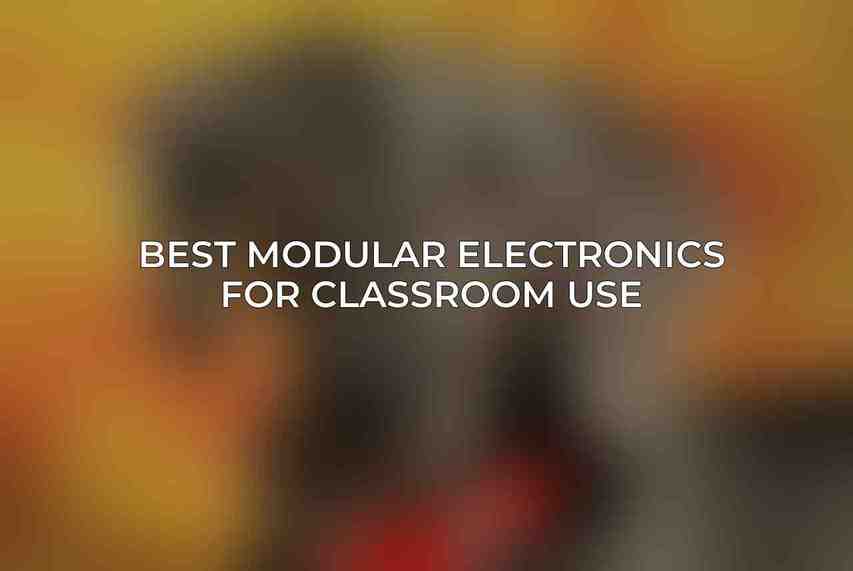Modular electronics are changing the world of classroom learning by offering students interactive and hands-on experiences that promote creativity, innovation, and problem-solving skills. These versatile devices allow for customization, repair, and upgrades, making them ideal tools for educators looking to enhance the learning environment. Here, we will explore some of the best modular electronics available for classroom use, their specifications, features, and the benefits they offer to students.
Modular electronics, in the context of education, refer to devices or kits that can be disassembled, reassembled, and modified to suit specific learning objectives. These gadgets come with interchangeable components that encourage experimentation and exploration, giving students the opportunity to gain practical skills in electronics, programming, and robotics. By integrating modular electronics into the classroom, educators can foster a more engaging and interactive learning environment that caters to diverse learning styles and interests.
Top Modular Electronics for Classrooms

1. Framework Laptop 13 (AMD)
- Specs: 13.5-inch display, AMD Ryzen 5 5600U processor, 16GB RAM, 512GB SSD, Windows 11 Pro.
- Features: Modular design for easy repairs and upgrades, lightweight and durable, long battery life.
Benefits: Promotes hands-on learning, teaches computer hardware skills, reduces e-waste.
The Framework Laptop 13 (AMD) is a versatile device that encourages students to delve into the inner workings of a computer. Its modular design not only facilitates easy repairs and upgrades but also instills a sense of ownership and understanding of technology among students. By using this laptop, students can learn about computer hardware, sustainability through repairability, and the importance of reducing electronic waste.
2. Kano Computer Kit
- Specs: Raspberry Pi 3B+ computer, case, keyboard, mouse, speaker, power supply, HDMI cable, microSD card.
- Features: Easy-to-assemble kit for children, drag-and-drop programming interface, access to online coding lessons.
Benefits: Introduces coding concepts, fosters creativity, and enhances problem-solving skills.
The Kano Computer Kit is designed to introduce young learners to the world of coding and technology in a fun and interactive way. By assembling their computer and engaging in coding activities, students can develop essential skills such as logical thinking, problem-solving, and creativity. The kit provides a hands-on approach to learning that empowers students to explore and create using technology.
You can find more information on Framework Laptop 13 (AMD) vs Competitors: Best for Education
3. littleBits Electronics Kit
- Specs: 12 electronic modules (LEDs, sensors, buttons, motors), snap-together design, easy-to-use software.
- Features: Endless project possibilities, hands-on experimentation, learning circuits and electronics.
Benefits: Develops critical thinking, encourages teamwork, enhances STEM learning.
The littleBits Electronics Kit offers students the opportunity to design and build electronic projects using modular components. By snapping together various modules, students can create anything from simple circuits to complex electronic devices. This hands-on approach fosters critical thinking, collaboration, and problem-solving skills while enhancing understanding of STEM concepts.
4. MaKey MaKey Invention Kit
- Specs: MaKey MaKey board, alligator clips, wires, conductive tape, software.
- Features: Turns objects into interactive controllers, supports multiple inputs/outputs, connects to any device.
Benefits: Encourages creativity, supports project-based learning, teaches about input/output devices.
The MaKey MaKey Invention Kit transforms everyday objects into interactive controllers, sparking students’ creativity and imagination. By connecting objects to the MaKey MaKey board, students can invent unique ways to interact with technology and create innovative projects. This kit promotes experiential learning and allows students to explore the boundaries of technology in a playful and engaging manner.
5. Sphero Mini Activity Kit
- Specs: Sphero Mini robot, charging cable, activity cards, coding app.
- Features: Programmable robot with LED lights and motion sensors, easy coding interface, supports multiple languages.
Benefits: Introduces robotics and coding, enhances computational thinking, develops problem-solving skills.
The Sphero Mini Activity Kit is an excellent tool for introducing students to robotics and programming concepts. By coding the Sphero Mini robot to complete various activities, students can learn valuable skills such as computational thinking, logical reasoning, and problem-solving. This kit presents a hands-on approach to learning that combines creativity with technology, making it a valuable resource for classroom activities.
modular electronics offer a myriad of benefits for classrooms by promoting hands-on learning, fostering creativity, and enhancing critical thinking skills. By incorporating these devices into educational settings, educators can create engaging and interactive learning experiences that prepare students for the challenges of the digital age. It is crucial for educators to embrace the potential of modular electronics and leverage them to revolutionize STEM education, equipping students with the skills they need to thrive in an increasingly technology-driven world. By investing in modular electronics for classrooms, educators are investing in the future of education.
Frequently Asked Questions
What are modular electronics?
Modular electronics are devices or systems that are created with interchangeable components, allowing for customization and flexibility in functionality.
Why are modular electronics beneficial for classroom use?
Modular electronics are beneficial for classroom use because they enable students to explore and understand various aspects of technology through hands-on experimentation and building.
What are some examples of modular electronics suitable for classroom use?
Some examples of modular electronics suitable for classroom use include Arduino kits, Raspberry Pi boards, modular robotics kits, and electronic prototyping platforms.
How can modular electronics enhance STEM learning in the classroom?
Modular electronics can enhance STEM learning in the classroom by fostering creativity, problem-solving skills, and collaboration among students in designing and building innovative projects.
Are modular electronics easy to use for educators and students with varying levels of technical expertise?
Yes, modular electronics are designed to be user-friendly and accessible to educators and students with varying levels of technical expertise, making them ideal tools for learning and experimentation in the classroom.

